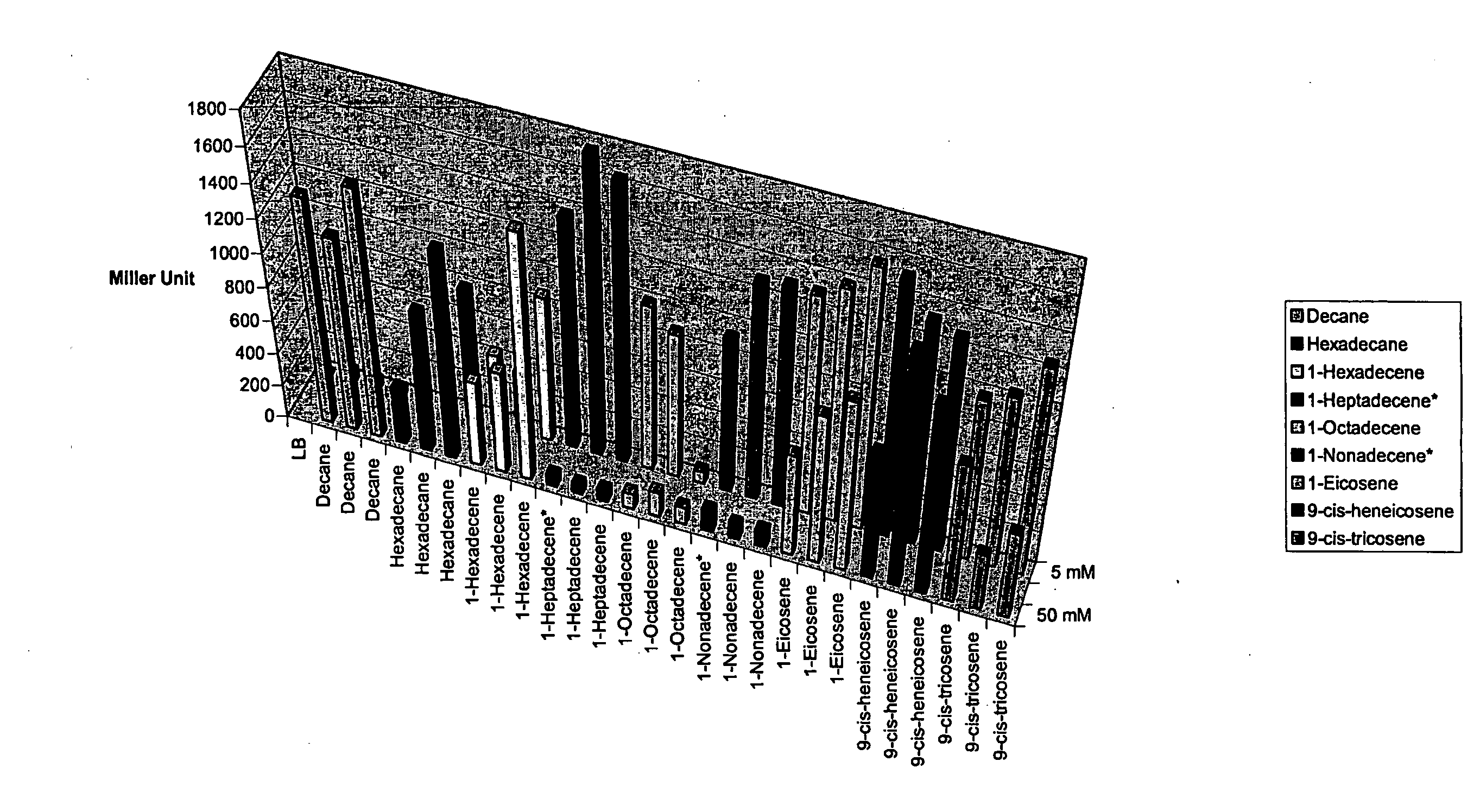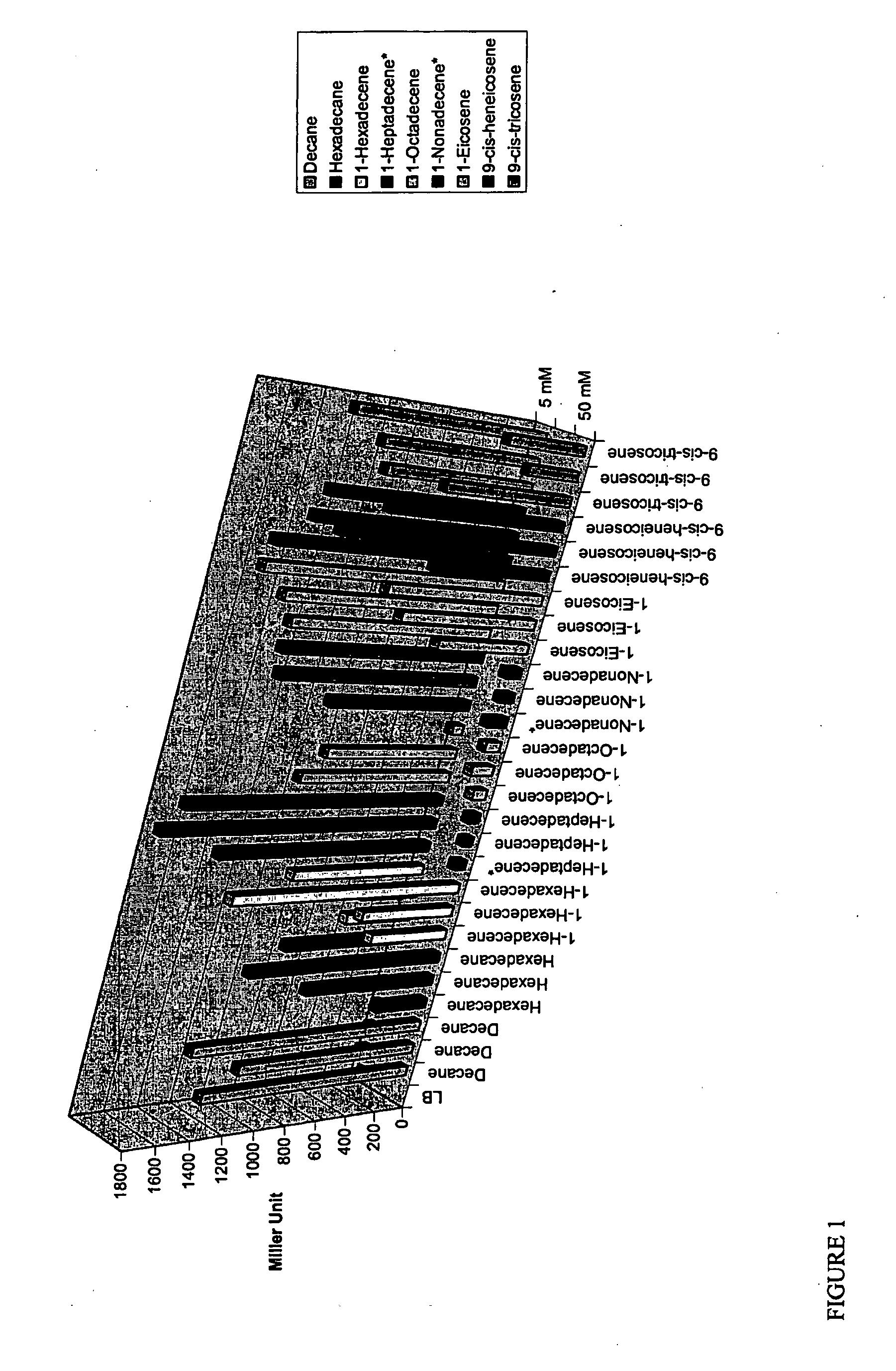Methods and Compositions for Identification of Hydrocarbon Response, Transport and Biosynthesis Genes
a technology of hydrocarbon response and biosynthesis, applied in the field of methods and compositions for identifying hydrocarbon response, transport and biosynthesis genes, can solve the problems of limited versatility, cost, and unique infrastructure requirements of renewable energy sources, and achieve time-consuming and labor-intensive effects
- Summary
- Abstract
- Description
- Claims
- Application Information
AI Technical Summary
Benefits of technology
Problems solved by technology
Method used
Image
Examples
example 1
Expression of GFP Using Acinetobacter AREs in E. coli
[0068]Hydrocarbon induced expression of the reporter gene GFP in E. coli is demonstrated as follows. Briefly, reporter gene constructs are constructed using the ARE from Acinetobacter baylyi ADP1 alkR / M locus (GenBank accession AJ002316, 7 Nov. 1997) (SEQ ID NO:1), Acinetobacter sp. M1 alkRb / Mb locus (GenBank accession AB049411, 27 Sep. 2000) (SEQ ID NO:6) or Acinetobacter sp. M1 alkRa / Ma locus (Genbank accession AB049410, 27 Sep. 2000) (SEQ ID NO:11). Various ARE constructs are amplified from Acinetobacter genomic DNA to include restriction sites amenable to cloning. The isolated ARE construct fragments are ligated into an appropriate vector together with a nucleic acid fragment containing the GFP gene. The resulting vectors are transformed into E. coli and monitored for hydrocarbon induced expression of GFP.
[0069]Three different ARE constructs are isolated from each Acinetobacter species genomic DNA. Each construct include the ...
example 2
Identification of Acinetobacter Genes Necessary for Screening Strain
[0078]As demonstrated by Example 1, Acinetobacter AlkR was expressed in E. coli, but the Acinetobacter ADP1 ARE (alkM-3) alone was insufficient for hydrocarbon induced expression of a reporter gene in E. coli. In some embodiments, at least one additional gene is necessary for to create the screening strain. This gene is identified by constructing an expression library from Acinetobacter genomic DNA and screening this library in E. coli harboring the ARE::GFP construct for GFP expression in the presence of hydrocarbons.
example 3
Hydrocarbon Induction of an ARE:Reporter Gene in Acinetobacter WH405
[0079]Acinetobacter strain WH405, an ARE::lacZ derivative of strain ADP1 (Ratajczak et al 1998), was scraped from an overnight plate into LB and diluted to OD600 0.07 (the cells can also be from an overnight culture, as long as cells are diluted in fresh LB). Alkane and alkene induction of the ARE was tested by adding a number of alkenes at 5 and 50 mM to culture tubes, followed by addition of the diluted WH405 solution into tubes (5 mL). Tubes were incubated in a 37° C. shaker overnight. The β-galactosidase activity assay developed by Miller was used to determine the level of induction by the different hydrocarbon from the overnight cultures.
[0080]Results are shown in FIG. 1. In summary, decane and hexadecane as well as various alkenes (1-hexadecene, 1-heptadecene, 1-heptadecene, 1-octadecene, 1-nonadecene, 1-eicosene, 9-cis-heneicosene and 9-cis tricosene) induced the ARE in Acinetobacter WH405. In addition, octan...
PUM
| Property | Measurement | Unit |
|---|---|---|
| physical | aaaaa | aaaaa |
| chemical | aaaaa | aaaaa |
| length | aaaaa | aaaaa |
Abstract
Description
Claims
Application Information
 Login to View More
Login to View More - R&D
- Intellectual Property
- Life Sciences
- Materials
- Tech Scout
- Unparalleled Data Quality
- Higher Quality Content
- 60% Fewer Hallucinations
Browse by: Latest US Patents, China's latest patents, Technical Efficacy Thesaurus, Application Domain, Technology Topic, Popular Technical Reports.
© 2025 PatSnap. All rights reserved.Legal|Privacy policy|Modern Slavery Act Transparency Statement|Sitemap|About US| Contact US: help@patsnap.com


